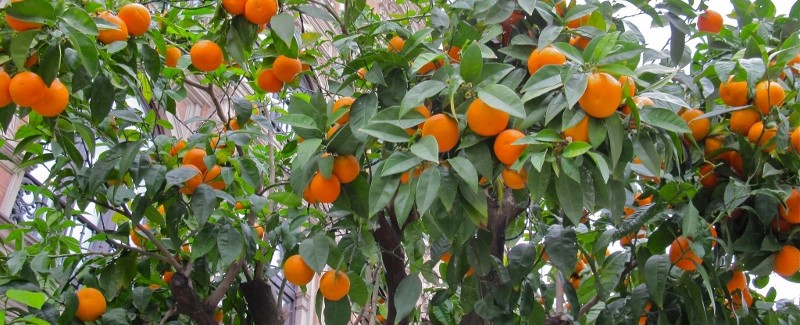
Why Oranges Don’t Grow in Montana
Ever wonder why some crops are only raised in certain areas of the country? Sure, the weather has something to do with it, but are there other factors that determine where certain crops are grown? How do these factors impact our access to fresh food and to locally-grown foods? We harvested the answers from Wayne Parrot, PhD, Crop and Soil Scientist at the University of Georgia, and Stephen Baenziger, PhD, Agronomy and Horticulture Professor at the University of Nebraska-Lincoln.
What determines which crops are grown in each area of the country?
Dr. Parrott: “It’s really a combination of traits of the particular crop and the associated economics. For example, coffee and bananas would never survive a winter, so they must be grown in warmer climates. Peanuts or potatoes have to be dug up, so those crops get grown in areas where sandy soil makes this easier. Corn and wheat would both grow well in Iowa, but corn is the more valuable of the two, so it gets preference there. Wheat then gets relegated to the drier areas where corn is more difficult to grow.”
Why can’t oranges be grown in Montana?
Dr. Baenziger: “They can’t take the cold. They’re a tree that can’t take freezes well. How many times do you hear about a frost in Florida killing orange trees? Imagine if that were in Montana. If you buy garden plants, there’s a hardiness zone that indicates whether a certain plant will grow in that zone. It’s a similar situation with crops. It’s important to buy (and plant) with hardiness zones in mind. If you’re in Montana, you never want to buy a plant that can’t take the cold temperatures!”
Where are most of the fruits and vegetables in the U.S. grown?
Dr. Parrott: “These can be grown in many parts of the country. California’s San Joaquin Valley has dry air that helps prevent diseases (as long as there is water for irrigation). As winter comes to an end, vegetable production starts in Florida, then moves northward as spring progresses and the days get warmer.”
Dr. Baenziger: “It really depends on two things – climate and labor force. A lot of vegetables are grown in southern states, where the climate is favorable and there’s access to a labor force. You often hear of migrant workers starting in California or Texas and moving northward. A lot of fruits and vegetables are still picked by hand, and the labor force is following the northward movement of fruit and vegetable production as the weather gets warmer.”
Can crops grown in certain areas change over time?
Dr. Baenziger: “Yes. At one time, Nebraska was the center for apple production, but right around World War II there was a very harsh winter, which killed the trees. No one was around to replant them because they were either fighting in the war or working to aid war efforts.”
What are some of the most commonly grown crops in the country? Where are these crops grown?
Dr. Baenziger: “The number one and two crops are corn and soybeans. Another one that is not often thought of as a crop is turf grass, because it’s in everybody’s yard. Corn is grown virtually everywhere there is enough heat. Corn is a heat-loving crop, so it needs heat to grow. It takes a lot of water in the summer, so sometimes farmers might switch to a more water-conserving crop, like sorghum. Soybeans are similar to corn, but tend to be a little more cold sensitive, so they aren’t grown in areas where freezes are more common. When you get into drought, that’s when you start to see more sorghum and wheat coming in more often. In the corn and soybean areas, wheat is mostly a rotational crop (meaning you rotate crops each year, because rotating crops helps control pests and diseases and improve soil health). In drier areas, wheat becomes the primary crop as it’s much more drought-tolerant. Cotton is grown in the South where it’s hot, and rice is grown mainly in California, Arkansas and some parts of Texas. Rice fields are flooded, and it takes quite a bit of water to grow that crop.”
What about growing seasons? Can most crops be grown year ’round?
Dr. Baenziger: “Most crops can’t be grown year ’round because they are acclimated to the climate, and most crops don’t grow through the winter. Crops can be grown at different times of the year in different areas of the country. For example, strawberries start in California, then move to Oregon, Washington and even into Canada. Then it will be strawberry seasons in South America. So somewhere in the globe fruit is in season, hence you can always have fresh fruit. Growing fruits and vegetables in greenhouses is another option.”
How do the limitations on crop growth affect food trends, like buying local foods?
Dr. Parrott: “As Dr. Baenziger mentioned, there is a seasonality to what crops can be grown locally. Cities out West must use lots of irrigation to grow locally, and they don’t always have it. Very large cities are unlikely to have enough open land around them to feed themselves locally.
I should point out that my grandmother in Kentucky ate local all her life, but it meant she spent long hours in the summer canning produce for the winter months. Fresh produce during the winter was out of the question. In this day and age, it can take less energy to grow the produce far away and ship it to areas where it is out of season, than to grow it locally and preserve it for the winter. It’s important to not automatically assume that because something is not local it is not sustainable. Many factors come into play that can affect the answer.”

























